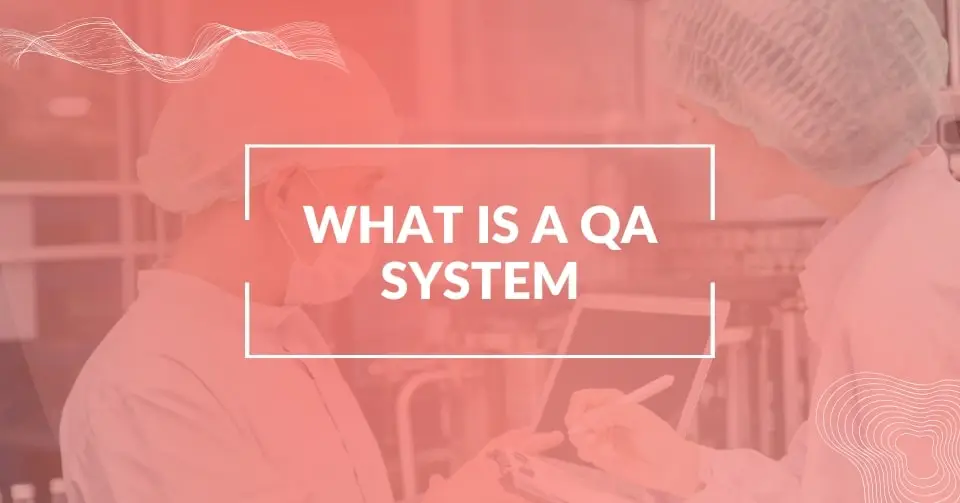In the food and beverage manufacturing world, where competition is already stiff, keeping your product quality intact becomes all the more important. Consider a Quality Assurance (QA) system as the infallible guardian, ensuring all items that roll off the production line are produced in conditions of highest safety, consistency, and delight to the customer.
Learn why it’s a must-have partner for any food and beverage manufacturer committed to being the best.
What Is a Quality Assurance System?
A QA system in food and beverage manufacturing is a structure of planned activities and processes that ensure quality at all production points.
Instead, a QA system uses proactivity and is designed to prevent software defects earlier in development. It includes extensive testing, real-time monitoring of all processes and procedures, and detailed documentation to ensure product quality and safety uniformity through standard adherence, including HACCP (Hazard Analysis and Critical Control Points), ISO 22000 norms, and FDA guidelines.
A QA (Quality Assurance) system in food and beverage manufacturing is a proactive framework of planning processes that ensure consistent product quality and safety at every stage of production. Unlike reactive quality control, a QA system prevents issues before they occur by incorporating real-time monitoring, rigorous testing, and thorough documentation. It aligns with industry standards such as HACCP (Hazard Analysis and Critical Control Points), ISO 22000, and FDA regulations to maintain compliance and uniformity in food safety practices.
What is the Importance of QA Systems in Food and Beverage Manufacturing?
Regulation is inevitable in an industry that has far-reaching effects on public health. With a strong QA system in place, manufacturers:
- Protect the Product: Eliminate impurities or variations in the final product to avoid recalls, lawsuits, and health risks. This is where quality assurance (QA) comes into play, as strong checks and controls are put in place to avoid these pitfalls.
- Ensure Consistency: Whatever the taste, texture, or appearance of your product, be consistent with it. Use QA systems to maintain a very high level of quality control throughout every batch system.
- Ensure Customer Satisfaction: QA systems can be tailored to comply with local, national, and international food safety standards, effectively addressing compliance challenges. By prioritizing quality and safety, you can build customer loyalty, encourage repeat business, and avoid costly fines associated with non-compliance.
- Increase Customer Trust: Clients have more faith in the products of brands that prove they regularly produce safe and quality merchandise.
- Improve Customer Satisfaction and Loyalty: This one is a bit self-explanatory, but of course, a robust QA system means providing a better user experience overall, which results in satisfied and loyal customers.
- Reduce Waste and Costs: QA systems help reduce waste, lower production costs, and increase overall efficiency by identifying potential issues early in production.
While QA systems focus on ensuring product quality, consistency, and safety, they are even more effective when paired with robust Food Safety and Quality Assurance (FSQA) practices.
FSQA integrates the safety-focused components of regulatory compliance with the quality-driven principles of QA, creating a comprehensive framework for manufacturers. An FSQA system is more effective and treats safety and quality as two sides of the same coin rather than separate issues.
Manufacturers can better manage risks by weaving FSQA principles into QA processes, staying compliant with regulations, and consistently delivering top-notch products. This synergy highlights why FSQA is important in food production. It ensures both safety and quality, protecting both consumers and brands.
Related reading: The Difference Between Food Safety and Quality Assurance.
What are the Key Components of a Quality Assurance System?
The QA system includes several essential components, each significant in ensuring the integrity of the product. The components include:
- Introduction of QC procedures – Quality Control (QC) is part of Quality Assurance (QA) and is used to test and evaluate products in different production intervals. It embraces quality assurance activities, susceptible and coordinated with implementation to ensure the products are of the given quality standard.
- Introduction of Standard Operating Procedures (SOPs) – SOPs are the operating instructions that ensure uniformity in task execution. They are the policies to be followed by the team as they perform the tasks, aiming to eliminate or minimize errors and variations in the final product.
- Managing Activities Involved in Documentation and Record-Keeping – Proper documentation is imperative to enhance traceability and regulatory compliance. It includes routine updates of the quality control measures undertaken, the results of such checks, the production processes, and any additional work.
- Employee Training – The efficiency of a Quality Assurance (QA) system largely depends on how adequately the personnel have been trained. Regular employee training allows them to understand the importance of product quality, how to maintain it, the procedures that must be followed, and what quality is acceptable.
- Continual Internal Auditing and Enhancing Internal Processes – Internal audits highlight weaknesses within the quality assurance framework. Programs for continuous improvement address such shortcomings by applying corrective actions, improving processes, and incorporating new techniques.
Steps To Implement a QA System in Your Food and Beverage Business
Establishing a QA structure requires a systematic approach to both design and implementation.
Here are the essential steps:
Step 1: Conduct a Gap Analysis
The first step would be to evaluate the current quality management practices and locate the gaps between the current state of any given process and the desired QA standards.
Step 2: Develop SOPs and QA Policies
Develop clearly defined SOPs concerning the stages during production processes, such as raw material handling, processing, and finished products’ packaging and distribution. Develop QA policies that include adherence to legal obligations.
Step 3: Set Up QA and QC Teams
Form separate QA and QC departments for quality checks, testing, and meeting various requirements.
Step 4: Implement Monitoring and Testing Procedures
Integrate testing techniques to control the quality of the product. Employ statistical process control (SPC) tools to help with data analysis and variance identification.
Step 5: Train Your Employees
Train workers regularly to inform them about the quality standards set and provide guidelines concerning SOPs and their role in maintaining the quality of the final products.
Step 6: Conduct Regular Audits
Internal audits will help you check whether the QA system works effectively. If improvements are needed, audits help implement the necessary changes.
What Are the Benefits of a Robust QA System?
Implementing a QA system in your food and beverage manufacturing business brings numerous advantages:
- Enhanced Product Safety: Ensures products are free from contaminants and meet safety standards.
- Improved Efficiency: Streamlines processes, reduces errors, and minimizes production downtime.
- Regulatory Compliance: Keeps your business compliant with food safety regulations, avoiding penalties and recalls.
- Customer Satisfaction: Builds trust and loyalty by consistently delivering high-quality products.
- Cost Savings: Reduces waste, rework, and costs associated with defective products.
What Are the Common Challenges in QA and How to Overcome Them?
While a QA system offers significant benefits, implementing and maintaining it can present challenges:
Challenge 1: Resistance to Change.
Employees may resist the changes. However, you can overcome this by involving them in developing the QA system and communicating the benefits.
Challenge 2: Inadequate Training
Poor training can lead to errors and non-compliance. Invest in better training programs to update your team on best practices and regulatory changes.
Challenge 3: Inconsistent Documentation
Improper documentation can lead to non-compliance and difficulty in tracing product quality issues. Implement a comprehensive document control system to ensure consistency.
Challenge 4: High Implementation Costs
The initial setup of a QA system can be costly. However, it benefits the initial investment in the long run through improved efficiency and reduced waste.
Conclusion
Traceability in food manufacturing is absolutely vital for ensuring food safety, maintaining quality, and staying compliant with regulations. As the global food supply chains grow increasingly intricate, being able to track ingredients and finished products from their source all the way to the consumer is key to preventing contamination, managing recalls, and building consumer trust. A solid traceability system boosts transparency and helps manufacturers adhere to the strict regulations set by the FDA, USDA, and international food safety standards like FSMA and HACCP.
Thanks to technological advancements, food manufacturers can now access digital traceability solutions like FoodReady that automate tracking, reduce errors, and enhance visibility throughout the supply chain. By utilizing tools like QR codes, RFID, blockchain, and real-time data analytics, businesses can swiftly pinpoint and address safety risks, reducing the chances of foodborne illness outbreaks. Moreover, effective supplier management and thorough documentation practices are essential for maintaining traceability from start to finish.
FAQs
QA is a proactive process that focuses on preventing defects by implementing systematic methods, while QC is reactive, identifying defects through inspection and testing.
QA system ensures product safety, consistency, and compliance with regulatory standards, which are critical in preventing foodborne illnesses and maintaining consumer trust.
QA audits should be conducted regularly, at least annually, or frequently based on risk assessments, product type, and regulatory requirements.
Training ensures employees understand quality standards and SOPs and their role in maintaining product quality, reducing errors, and enhancing compliance.
Technologies like automated testing, data analytics, and digital traceability tools can enhance food quality management and assurance systems by providing real-time insights, reducing human error, and improving decision-making.








